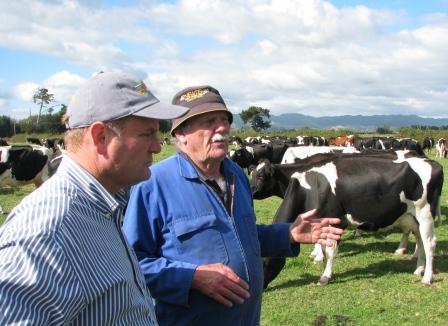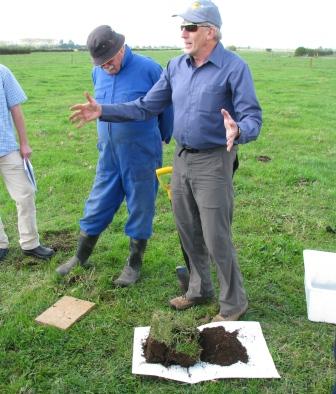Carbon Farming News |
 |
Issue 6, June 2010 |
|
Hi,
Welcome to the Carbon Farming Group newsletter. We hope you enjoy the topics we have covered below, which include website changes, lamb carbon footprint, CFG field visit, soil carbon assessment and a kiwifruit carbon project.
|
Info Sheets Updated |
Info sheets 2, 4, 5, 7, 8, 9, 10, & 11 have been updated to incorporate the new Emissions Trading Scheme changes, latest soil carbon commentary and latest carbon trading data. These can be accessed on the following table below or on the Articles page on our website here.
Issue |
Date |
Link |
Info Sheet 2 - Soil Carbon |
Mar 2010 |
Download pdf |
Info Sheet 4 - NZ Carbon Programs |
Mar 2010 |
Download pdf |
Info Sheet 5 - Carbon Trading |
Mar 2010 |
Download pdf |
Info Sheet 7 - Managing Farm Emissions |
Mar 2010 |
Download pdf |
Info Sheet 8 - Sheep and Beef - Carbon Example |
Mar 2010 |
Download pdf |
Info Sheet 9 - Dairy Farm - Carbon Example |
Mar 2010 |
Download pdf |
Info Sheet 10 - Dairy, Sheep and Beef - Carbon Example |
Mar 2010 |
Download pdf |
Info Sheet 11 - Arable Farm - Carbon Example |
Mar 2010 |
Download pdf |
|
Lamb Greenhouse Gas Footprint
|
A study on the carbon footprint of lamb from "NZ paddock to UK plate" has concluded that a 100g serving will emit 1.9kg of carbon dioxide, only 5% of the total emissions are a result of transport. The full report can be viewed here. This study was completed by AgResearch under the Ministry of Agriculture and Forestry’s greenhouse gas footprinting strategy which aims to assess the carbon footprints of up to 80% of New Zealand's export primary products. For a full list of work being done under this strategy click here. Another major objective of this work is to consolidate a common assessment method for calculating footprints of similar products from all over the world. New Zealand, through MAF, is taking the initiative in in working with other countries to achieve a common standard for measuring the carbon footprint of primary products. To see how carbon footprinting is different from the ETS and the Kyoto Protocol see our summary here.
|
| CFG Farm Visit |

Peter Berryman explains his farming technique to CFG Chairman Rick Braddock |
We held a recent meeting in Edgecumbe at a farm owned and run by Peter Berryman. Berryman is a client of Peter Burton of Eco-logic who organized the day. Berryman uses a fertilizer regime including a range of beneficial soil fungi and bacteria which encourages the “biology” to assist the improvement of the soil structure and therefore pasture production. The farm is a 70ha dairy farm with a 10ha of run-off. The farm runs 190 milking cows at an average of 2.7 cows per hectare. The key difference from conventional farming systems is the use of calcium through the measured application of dolomite and lime. Berryman’s philosophy revolves around looking after the soil which in turn looks after the pasture which results in healthy and productive live stock. As an example of having good pasture and breeding stock the empty rate is around 7%.
The production results have been compared to a nearby monitor dairy farm in the table below:
Data as at April 2010
|
Berryman |
Local Monitor Farm |
Cows/ha |
2.7 |
3.4 |
2009/2010 Prod kg/ha |
1300 |
1025 |
Kg/cow |
467 |
300 |
Condition Score |
4.5 |
3.7 |
|
Visual Soil Assessment
|

Graham Sheppard demonstrates how easy it is to do a Visual Soil Assessment |
While on the Berryman farm we were given a field lesson on how to use the visual soil assessment (VSA) developed by Graham Shepherd. This is a very straight forward soil testing method and the results were very interesting. The VSA seems like a very useful tool for farmers to gauge soil health. We have put a summary of the VSA on our website here.
|
Agricultural Global Research Alliance |
Not a lot to report here, a meeting was held at Te Papa in early April which was attended by 28 of the 29 member countries. According to Tim Groser, who chaired the meeting, the group managed to “come up with a further draft of the work programme and … the charter”. It is reported, however, that the members did agree on three research strands: crop management research led by the United States; livestock issues led jointly by the Netherlands and New Zealand; and rice paddy farming investigations led by Japan. A further research area to study the role of soil carbon in agricultural emissions is also under consideration .
| http://www.scidev.net/en/climate-change-and-energy/global-agricultural-alliance-sets-its-research-agenda.html?utm_source=link&utm_medium=rss&utm_campaign=en_climatechangeandenergy |
|
Study on the role of carbon in Kiwi Fruit Production |
The Carbon in Orchard Soils Team (COST) has been funded by the Sustainable Farming Fund in order to quantify above and below ground carbon storage in kiwifruit orchards. The COST group believes that carbon storage offers mitigation for climate change and enhances water and nutrient use efficiency; thereby providing adaptation to climate change. Better knowledge on carbon storage will contribute to the eco-verification of NZ’s image of ‘clean-green’ kiwifruit. For more information on this project click here. |
Website Updates |
Recent updates to the Carbon Farming Group website include:
- Info sheets updated
- ETS Case studies updated
If you have any questions about climate change and the rural sector, or have ideas/suggestions that you’d like to share please contact us on 0800 123 733 or [email protected]
Best Regards,
Clayton Wallwork
Trustee
Carbon Farming Group |
| |
|

